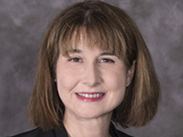|
||||||||||||||||||||||||||||||||
|
||||||||||||||||||||||||||||||||
 Computational methods make a difference when the challenge is to develop a new material for a given technology or to adjust material properties to fit a specific application.
Computational methods make a difference when the challenge is to develop a new material for a given technology or to adjust material properties to fit a specific application.
In the end of September, the computational materials scientist Susan Sinnott will talk about this topic of her expertise in a plenary lecture at the XV Brazil-MRS Meeting. Sinnott is Professor and Department Head of Materials Science and Engineering at Pennsylvania State University (USA). She is also the editor-in-chief of “Computational Materials Science” (Elsevier).
Susan Sinnott received her B.S. degree in Chemistry (with honors) from the University of Texas in 1987 and her doctoral degree in Physical Chemistry from Iowa State University in 1993. Then she worked as a postdoctoral associate at the U.S. Naval Research Laboratory until 1995. After that, she became a faculty member of the University of Kentucky. In 2000, she began her tenure at the University of Florida (UF). In 2012, she was named the Alumni Professor of Materials Science and director of the Cyberinfrastructure for Atomistic Materials Science at UF. In 2013, she was president of the American Vacuum Society (AVS). In 2015, she joined the Pennsylvania State University (Penn State).
Susan Sinnott is the author of more than 210 refereed journal papers and 8 book chapters. She has over 10,000 citations and an h-index of 46, according to Google Scholar.
She is a Fellow of the Materials Research Society, American Physical Society, American Ceramic Society, American Vacuum Society, and American Association for the Advancement of Science.
In the XV Brazil-MRS Meeting, Susan Sinnott will not only deliver the plenary lecture “Role of Atomic-Scale Modeling in Materials Design and Discovery”, but also take part in the roundtable “Meet the editors” to discuss scientific publication issues. Besides her position as editor-in-chief of “Computational Materials Science”, this scientist serves as associate editor, principle editor and divisional associated editor for other journals.
Here follows a short interview with the scientist.
SBPMat newsletter: – In your opinion, what are your most significant contributions to the field of materials modeling? Explain them very briefly and, if possible, share references of resulting publications or patents, products etc.
Susan Sinnott: – My research program uses computational atomistic methods to design and investigate materials. This area has seen tremendous growth in the last two decades because of a combination of factors, including the increasing availability and low cost of fast computers, the refinement of atomistic methods, the shrinking of device dimensions, and the improved ability of experimentalists to study materials at the nanometer scale. It approaches well-established continuum level modeling (such as finite element analysis) and fluid dynamics at high length scales (100s-1000s nanometers), and overlaps with traditional physics and chemistry at small length scales (1-10 nanometers).
A major contribution from my research group is the development of inventive methods to enable the modeling of new material systems at the atomic level. In particular, my collaborators and I developed a new empirical, reactive potential for molecular dynamics simulations that allows for the modeling of heterogeneous material systems at the atomic scale, something that has traditionally only been possible with computationally intensive first principles methods such as density functional theory. This method has allowed us to investigate such otherwise intractable problems as Cu thin film growth on ZnO surfaces, and model the catalytic activity of metal clusters on oxide surfaces. These potentials have been incorporated into an open-source massively parallel molecular dynamics software developed at Sandia National Laboratory to make them available to the modeling community.
Some relevant publications are:
SBPMat newsletter: – In the abstract of your plenary lecture, you mention the concept of “materials by design”. Could you explain this idea in a few words? Today, is “materials by design” a fact or a promise?
Susan Sinnott: – The ability to design a material with desired properties a priori using computational methods has been a promise of the field of computational materials science for many years. This promise relies on designing materials that do not currently exist or with properties that are desired from compositions that are largely unknown. The day that we can input the properties desired for a given part or device into a computer and have it predict the composition and microstructure or morphology needed to produce those properties has not yet arrived but remains the ultimate goal of “materials by design” initiatives. Currently, the integration of computational and experimental approaches is more complete than ever before. This enables computational materials science methods to make predictions that can be subsequently validated, and for experimental observations to be explained. Advances depend on continued improvements in the accuracy and predictability of computational methods along with continuing improvements in the linkages of the computational results to data from experimental characterization and production methods. An integral component to the new paradigm for materials design and discovery is the production and integration of datasets from calculations, simulations, experiments, or a combination of all of these. Therefore the seamless integration of database mining and materials informatics methods with conventional experimental and computational materials science methods is required. Lastly, the materials community must reach a critical comfort level and associated understanding of the strengths and limitations of coupling these methods so that such comparisons can be made on a routine basis.
A relevant paper that discusses these ideas in more detail is:
“Material design and discovery with computational materials science”, S.B. Sinnott, Journal of Vacuum Science and Technology A 31, 050812 (2013)
SBPMat newsletter: – If you desire, leave an invitation for our readers to go to your plenary lecture at the XV Brazil-MRS Meeting.
Susan Sinnott: – I invite you to find out more at my plenary lecture at the XV Brazil-MRS Meeting.
Link to the abstract of Susan Sinnott´s plenary lecture at the XV Brazil-MRS Meeting: http://sbpmat.org.br/15encontro/speakers/abstracts/10.pdf